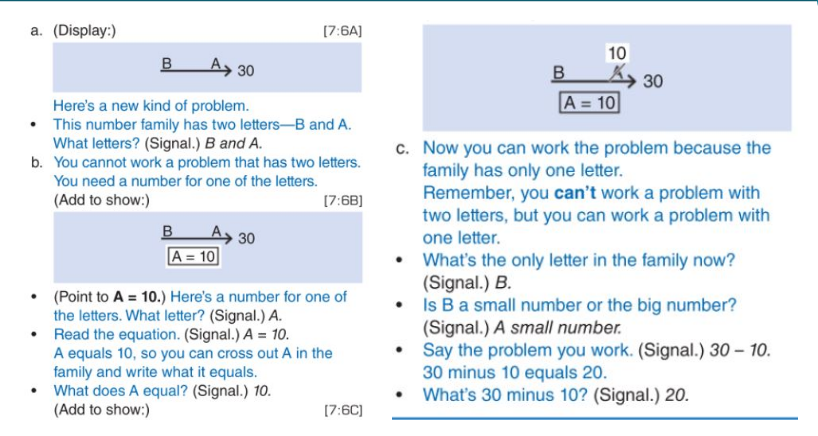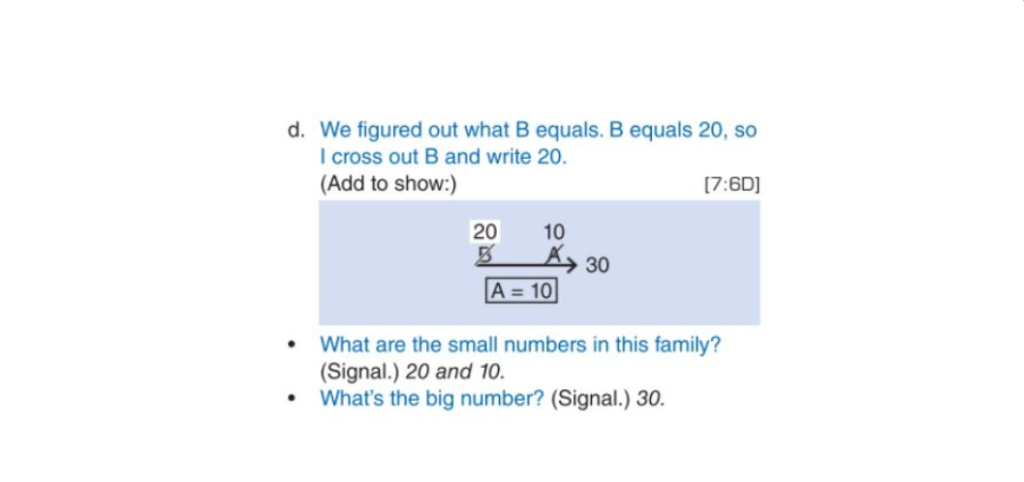Back to Course
Teach Connecting Math Concepts D (4)
0% Complete
0/0 Steps
-
Module introduction5 Topics
-
Overview21 Topics|2 Tests
-
Cover
-
Lesson objective
-
Opening the lesson
-
Direct instruction overview
-
CMC overview
-
Teacher’s role in motivation
-
Video – Using affirmations in lessons
-
CMC D materials
-
Time requirements
-
Placement testing
-
Check Your Understanding
-
Grouping, seating, STAR, transitions
-
Video – Routines for transitions
-
Script features
-
Script with brackets
-
Board work
-
Lined-paper icons
-
Math learning behaviours
-
Test Your Understanding
-
Review
-
Lesson completed
-
Cover
-
Connecting CMC to Oz-e-maths15 Topics|2 Tests
-
Addition/subtraction track: foundations, number families and facts25 Topics|3 Tests
-
Cover
-
Lesson objective
-
Opening the lesson
-
Point-touch signal
-
Video: Point-Touch Signal
-
Auditory signal
-
Video – Number families, signal and wait time
-
Addition number family foundations
-
Corrections and repeat until firm
-
Video – Error Correction Procedure
-
Correction tips
-
Check Your Understanding
-
Addition number family foundations continued
-
Foundations continued
-
Addition and subtraction facts overview
-
Addition and subtraction facts
-
Check Your Understanding
-
Droning and corrections
-
Timed fact practice
-
Corrections for number families
-
Video – Number families and correcting errors
-
Observe students and give feedback
-
Test Your Understanding
-
Review
-
Lesson completed
-
Cover
-
Addition/subtraction track: word problems, column problems and tables21 Topics|2 Tests
-
Cover
-
Lesson objective
-
Opening the lesson
-
Addition/subtraction word problems
-
Start-end problems
-
Correction spoken and written
-
Video – Error Correction Procedure
-
Start-end problems
-
Comparison problems
-
Classification word problems
-
Addition column problems
-
Column addition continued
-
Column subtraction
-
Column subtraction continued
-
Check Your Understanding
-
Family tables
-
Corrections and repeat until firm
-
Family tables continued
-
Test Your Understanding
-
Review
-
Lesson completed
-
Cover
-
Multiplication/division track: foundations, number families and facts18 Topics|2 Tests
-
Cover
-
Lesson objective
-
Opening the lesson
-
Foundations overview
-
Count by
-
Multiplication/division number families overview
-
Multiplication/division number families
-
Multiplication/division number families continued
-
Check Your Understanding
-
Corrections and repeat until firm
-
Multiplication/division facts overview
-
Multiplication/division facts
-
Multiplication/division facts continued
-
Script success
-
Video – Lesson practice
-
Test Your Understanding
-
Review
-
Lesson completed
-
Cover
-
Multiplication/division track: word problems, column problems and place value track19 Topics|2 Tests
-
Cover
-
Lesson objective
-
Opening the lesson
-
Multiplication/division word problems overview
-
Each or every
-
The tick
-
Times word problems
-
Times word problems continued
-
Multiplication column problems
-
Corrections spoken and written
-
Check Your Understanding
-
Multiplication with carrying
-
Division problems
-
Place value
-
Reading thousands numbers
-
Writing thousands numbers
-
Test Your Understanding
-
Review
-
Lesson completed
-
Cover
-
Inequality, mental math, equations, money and measurement tracks17 Topics|2 Tests
-
Estimation, geometry and maps tracks17 Topics|2 Tests
-
Fractions, time and graphs tracks19 Topics|2 Tests
-
Cover
-
Lesson objective
-
Opening the lesson
-
Fractions
-
Auditory signal
-
Video: Auditory Signal
-
Fractions that equal one and number lines
-
Adding and subtracting fractions and comparing fractions
-
Fractions continued
-
Check Your Understanding
-
Corrections
-
Time
-
Point-touch signal
-
Video: Point-Touch Signal
-
Time continued
-
Graphs
-
Test Your Understanding
-
Review
-
Lesson completed
-
Cover
-
Motivating students and independent work25 Topics|2 Tests
-
Cover
-
Lesson objective
-
Opening the lesson
-
Independent work
-
Independent work expectations
-
Video – Independent Work
-
Work checks
-
Work checks for independent work
-
Conducting work checks
-
Video – Work-checks
-
Independent work input on Student Progress Tool
-
Check Your Understanding
-
Basis of student motivation
-
Teacher-student game
-
Teacher-student game points
-
Video – Points in the teacher-student game
-
Providing affirmations
-
Video – Using affirmations in lessons
-
Communicate in a positive manner
-
Video – Positive praise
-
Specific positive feedback
-
Video – Using specific positive praise
-
Test Your Understanding
-
Review
-
Lesson completed
-
Cover
-
Mastery tests23 Topics|2 Tests
-
Cover
-
Lesson objective
-
Opening the lesson
-
Mastery tests
-
Conducting mastery tests
-
Using mastery test information
-
Providing remedies
-
Video – Reviewing remediation and retesting
-
Mastery tests on SPT
-
Video – Inputting data on SPT
-
Cumulative tests
-
Flight path concept
-
Check Your Understanding
-
Expected lesson pacing
-
Lesson progress on SPT
-
Pacing of instruction
-
Effective transitions
-
Video – Teaching routines for effective transitions
-
Teaching routines
-
Video: Effective Routines
-
Test your understanding
-
Review
-
Lesson completed
-
Cover
-
Bringing it all together28 Topics|3 Tests
-
Cover
-
Lesson objective
-
Opening the lesson
-
Auditory signal
-
Video: Auditory Signal
-
Corrections and repeat until firm
-
Video – Counting with error corrections
-
Corrections tips
-
Lesson 32, exercise 1
-
Point-touch signal
-
Lesson 32, exercise 2
-
Lesson 32, exercise 3
-
Check Your Understanding
-
Observe students and give feedback
-
Lesson 32, exercise 4
-
Lesson 32, exercise 5
-
Corrections spoken and written
-
Lesson 32, exercise 6
-
Check Your Understanding
-
Lined-paper icons
-
Lesson 32, exercise 7
-
Lesson 32, exercise 8
-
Lesson 32, exercise 9
-
Script success
-
Video – Lesson practice
-
Test Your Understanding
-
Review
-
Lesson completed
-
Cover
-
Module evaluation survey1 Topic
Participants 543
Lesson 4,
Topic 14
In Progress
Foundations continued
ddewell@goodtogreatschools.org.au August 7, 2023
Lesson Progress
0% Complete

Foundations continued
In lesson seven, students work with number families that have two letters and one number. An equation that gives the value for one of the letters appears under the number family.


The process

The process is:
- Display the problem and say, ‘Here’s a new kind of problem. This number family has two letters – B and A. What letters?’ and signal.
- Say, ‘You cannot work a problem that has two letters. You need a number for one of the letters’, and add to show.
- Point to A = 10 and say, ‘Here’s a number for one of the letters. What letter?’ and signal.
- Say, ‘read the equation’, and signal. ‘A equals 10, so you can cross out A in the family and write what it equals. What does A equal?’ signal and add to show.
- Say, ‘Now you can work the problem because the family has only one letter. Remember, you can’t work a problem with two letters, but you can work a problem with one letter,’ Ask, ‘What’s the only letter in the family now?’ and signal.
- Ask, ‘Is B a small number or the big number?’ and signal. ‘Say the problem you work’, and signal. ’30 minus 10 equals 20. What’s 30 minus 10?’ and signal.
- Say, ‘We figured out what B equals. B equals 20, so I cross out B and write 20’, and add to show. Ask, ‘What are the small numbers in the family?’
Turn to page 41 in CMC D Teacher’s Guide. Practise teaching lesson 7, exercise 6 with no student errors. Read exercises, information and teaching note.

